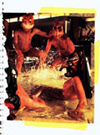 This 1991 release marked the beginning of the trilogy that many regard to be some of Andrew McKenzie's finest and most inspired work. Appropriately enough, its 2004 reissue by devoted super-fan Frans de Waard (Beequeen) marked the beginning of something still more notable: an ongoing campaign to track down and reissue as many hopelessly unavailable Hafler Trio albums as possible—with all omissions, glitches, and compromises eradicated and all financially suicidal packaging triumphantly intact.
This 1991 release marked the beginning of the trilogy that many regard to be some of Andrew McKenzie's finest and most inspired work. Appropriately enough, its 2004 reissue by devoted super-fan Frans de Waard (Beequeen) marked the beginning of something still more notable: an ongoing campaign to track down and reissue as many hopelessly unavailable Hafler Trio albums as possible—with all omissions, glitches, and compromises eradicated and all financially suicidal packaging triumphantly intact.
One of the qualities that makes Kill the King—a single 73-minute "ambient" piece—such a satisfying work is that McKenzie balances his characteristically aggressive contrarian and experimentalist impulses with massive, sustained, and subliminally buzzing drones and an occasional languorous pulse.Such concessions to listenability are quite uncommon in Hafler Trio's oeuvre, but I find them to be quite welcome when they appear.I am certainly a fan of H3O's more mischievous, bizarre, and abrasive tendencies, but having them presented within a context of semi-conventional structure and musicality definitely makes them more rewarding over multiple listens.I suspect Andrew would hate to hear that though.In fact, he seems to have had some misgivings about Kill the King's direction even while he was making it, as he managed to only narrowly avoid making a perfect ambient drone album through an artful act of late-song self-sabotage (a brief, but thoroughly cringe-inducing, dental drill interlude).
Atypically, Hafler Trio actually seems to have been almost an actual trio for this album, as McKenzie was allegedly joined by artist/short wave radio enthusiast John Duncan and composer Zbigniew Karkowski.I say "allegedly" because they are not credited anywhere on the reissue, though McKenzie cryptically mentions that he was assisted by "a disappeared" and"a never was." He also mentions that he composed one track using "a never can."More concretely, performance artist/sexologist Annie Sprinkle makes an actual credited appearance, lending her voice to be chopped and mangled into unrecognizability for a cathartic and disquieting mid-song sequence (a fascination that Andrew more fully explored in later years with the help of Blixa Bargeld, David Tibet, and Jónsi).Aside from Sprinkle and a distorted recording of a different woman speaking at the album's onset, however, it is impossible to tell where any of the sounds may have originated, as they are all distilled into either a swirling, quivering shimmer or an ominous rumble.
McKenzie has long been quite hostile toward digital release (and sharing) of his music and it is easy to see why.Kill the King (as well as many other H3O releases) is more of a bizarre multimedia experience than an album—to miss the art and text is to miss something quite integral to the H3O vision.In fact, the accompanying booklet is a masterpiece in its own right, both as a feat of graphic design and as an impenetrable enigma.I am almost completely certain that the whimsically disquieting pictures, pages of brief evocative text, six seemingly extraneous song titles, and random (?) words in a silver font are mere red herrings that have nothing to do with the music, but I still have a sliver of doubt.And if they are, I am forced to wonder if McKenzie threw them in to be deliberately annoying and misleading, or if there is something deeply witty or profound being hinted at.Regardless of their original intent, all of those little touches combine to make it clear that this object is coming to me from a rather curious and alien place and bears little resemblance at all to the comparatively homogenous commodities released by "serious" musicians that want to be liked.In recent years, however, McKenzie has taken his passion for unique packaging to the furthest possible extreme, forgoing CDs entirely in favor of offering one month of his creative life to create an individualized, one-of-a-kind "art object" for anyone who can finance it.
An amusing (and probably intentional) irony that I noticed when listening to Kill the King is that, if I didn't know better, it would be totally plausible for a brilliant psycho-acoustic researcher to have been involved in the making of this album (like fictitious founding member Dr. Edward Moolenbeck).Or maybe the irony is that Andrew himself is something of a brilliant psycho-acoustic researcher.Superficially, this is drone music, but the attention to minor detail and pure sound is on a level that few have the ability or willingness to attempt.It's almost like this album could have emerged from an aborted military experiment to create sound waves that are so vibrant and psychotropic on a microcosmic level that hapless enemy combatants would be unable to do anything but listen intently.This is, quite simply, an utterly absorbing and unpredictable release from one of the most twisted and calculating minds in modern music.
Samples:
 
 
Read More

